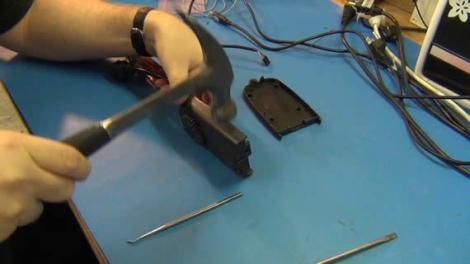
When [Todd Harrison’s] Christmas lights stayed on well past the pre-defined shut off time, he knew there was something wrong with the timer. He took the device into his workshop and spent some time diagnosing and repairing the device, a process he recorded for all to see.
After busting the screw-less timer open with a hammer, he inspected the PCB for any apparent signs of damage. After seeing what looked like a damaged transistor, he desoldered it from the board for testing. After the transistor passed his tests with flying colors, [Todd] assumed that the fault had to be in the relay which the transistor was responsible for switching.
Sure enough, the relay had shorted out, and upon cutting it open he found that the contact points were fused together. He separated and sanded the contacts down, enabling him to get the timer working – at least for the time being.
Part of [Todd’s] goal with this video was to show off different methods of desoldering, including a manual solder sucker (my favorite), desoldering braid, and a purpose built desoldering iron. If you’re in the market for some desoldering tools, but don’t know what to buy, [Todd] is more than happy to offer his advice.
Continue reading to see a video of [Todd’s] troubleshooting process.
[youtube=http://www.youtube.com/watch?v=VUAu_zXsudM&w=470]















I actually just hacked a broken light timer. The knob was busted so I couldn’t fix it. It ended up turning into this(http://www.instructables.com/id/3-Channel-arduino-Powered-Christmas-Light-Controll/). Although, nothing from the original timer made it into it.
Troubleshooting (n). A process involving busting a broken thing open with a hammer.
I like the cut of this man’s jib.
Hear, hear!
nothing beats a hammer when it comes to opening up glued together plastic casings.
Agreed. :) Though judicious application of a C-clamp, along with some time and patience, can sometimes pop the glue joints with less risk of damage to the casing.
I’m guessing he hasn’t worked with relays that much, as that should be been the FIRST thing to look at. (And if it doesn’t have a relay, check the SCR/TRIAC. Then move on to the other goodies.
But now, he needs a new box eh?
Anything mechanical is prone to fail. I would of gone with the relay first.
Indeed I was immediately thinking it extremely odd that when you have a mechanical device that switches mains all the time he’d instead would think it was a transistor running within specs.
Relays are anyway designed for a limited number of cycles because of the arcing when switching mains, and how well it lasts depends on the composition of the contact surfaces.
And what he should test for is if the anti-arcing parts for the relay are still OK, since those can also die from spikes.
And you should use a proper solvent/contact cleaner, or even alcohol or baking soda might be better, rather than sanding paper to clean contacts.
Not that I’m good at such stuff, it’s always easier to be a smart-ass in comments.
I have a high-current timer at home, to turn off a water cooler at night. It has a terrible one-button interface, and you have to program it outside the operating time.
(eg, if you want it on between 7am and 8am, then you must not program it between 7-8am)
If you do program it during the operating time, then it works just like an expensive switch (you can turn it on or off, but it won’t turn itself on or off.) Also, it only does on-the-hour changes.
So this post is inspiring… maybe a little hacking to build a better interface!
or maybe just a few bucks to by a decent timer. Geez, I thought the cheap one I bought was crappy. :)
ok, just read “high current”…so maybe you don’t want the cheap one I bought. Forgive me, I’ll retreat back into my hole now.
I’m glad you have got the relay working.
It’s worth thinking about what made the relay fail.
With some relays it can just be dist on the contacts, but not with yours as it was in a sealed relay box in a sealed box.
I would guess it was because too much load was going through the relay, because you plugged in too many Christmas lights.
You need to check that the fuse in the plug is the same or a smaller value than the relay can handle.
All English plugs are fitted with a fuse these days.
If your US plug dose not have a fuse then you could fit a small 20mm one inside the box.
PS. Americans refer to the live wire as the hot wire.
If it’s too hot it means that too much load is going through the wire and it is about to meld.
If it’s a live wire, then it is living and has not yet died.